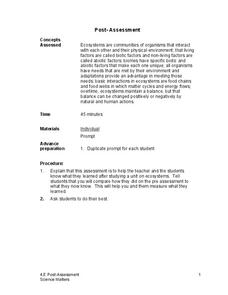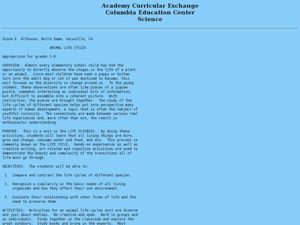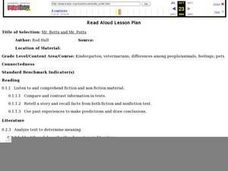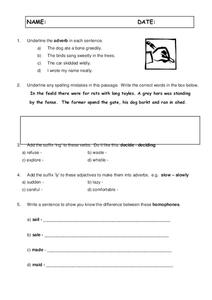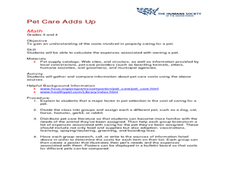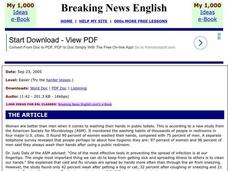Curated OER
ASL: Lesson 10
Focus on learning how to sign cardinal and ordinal numbers, nouns, and lexicalized fingerspelling. Here is lesson 10 of the series on learning ASL. Provided, are multiple links that provide a visual guide to proper signing. Teach your...
Curated OER
Honey Bees and Communication
Did you know that honey bees dance to communicate information? Do you know why bees use hexagons to build their hives? The Honeybee Man, Brilliant Bees, and Show me the Honey provide background information on how honey bees communicate....
Curated OER
Where is Shirley the Elephant?
Young animal lovers engage in a instructional activity that's all about elephants. They access an elephant sanctuary website and read a story about Shirley the elephant. They perform a series of activities based upon that story, and also...
Curated OER
How Many?
Establish 1:1 correspondence by counting students, first one gender, then the other. Give each child a colored cube (one color for boys, another for girls) and have small groups determine more or less and how many all together. As a...
Science Matters
Post-Assessment
Twenty questions make up an assessment designed to test super scientists' knowledge of ecosystems. Scholars answer multiple-choice and short-answer questions about organisms, food chains, energy flow, and more.
Silver Burdett Ginn
Study Buddies: Adding And Subtracting Fractions With Unlike Denominators
Pair up your math pals to teach each other about adding and subtracting uncommon denominator fractions! Step-by-step instructions are provided as well as five practice problems.
Curated OER
Data Handling
For this data handling worksheet, students interpret data found in table, graphs and charts. They organize data and draw bar charts. This two-page worksheet contains 2 multi-step problems.
Curated OER
Animal Life Cycle
Students conduct hands-on experiments. For this life cycle lesson, students are able to observe a variety of animals as they travel through their life cycle (brine shrimp, mealworms, frog eggs and chicken eggs). Students respond to...
Curated OER
"Mr. Betts and Mr. Potts"
First graders listen to the book "Mr. Betts and Mr. Potts" and examine the career of being a veterinarian. They categorize animals based on whether they could be house pets or not, develop a class pet graph, and list the various...
Curated OER
"A Pig is Big"
Students explore the concept of big, bigger, and biggest. They examine and classify items by size, listen to and discuss the book "A Pig is Big," complete a fill in the blank activity, and create a tri-fold that illustrates two items...
Curated OER
Hottest, Coldest, Highest, Deepest: Science, 4th Grade
Fourth graders investigate weather patterns in their home state of Utah. After creating KWL charts, they research weather and geographical data to locate the state's extremes. As an extension, 4th graders write and illustrate books about...
Curated OER
Breaking News English: Londoners Offered BLT for SAD
In this English worksheet, students read "Londoners Offered BLT for SAD," and then respond to 47 fill in the blank, 7 short answer, 20 matching, and 8 true or false questions about the selection.
Curated OER
Tenses
In this countries worksheet, students choose the correct tense of the word to complete sentences about counties, answer multiple choice questions, and find countries in a word search. Students complete 3 activities.
Curated OER
Metaphors
In this metaphor worksheet, students read statements that contain metaphors, then choose the statement that explains the meaning of each. A reference website if given for additional resources.
Curated OER
Figurative Language 2
Students read nursery rhymes and advertisements to identify examples of figurative language. As a class, students discuss the use of figurative language and its effectiveness in advertising, children's books, rhymes, poetry, etc. ...
Curated OER
The Doctor Said Open Up and Say /o/
Students complete a variety of activities related to the short /o/ sound. As a class they recite a tongue twister, and trace and write the letter O. Students then listen to the book "In the Big Top," and write down the words from the...
Curated OER
Spelling Plurals
In this spelling plurals worksheet, students study the 5 common rules for spelling plurals. Students fill in a chart in which the singular nouns are made plural. Then students find plurals in their reading books and classify them...
Curated OER
Animal Life Cycles
Students participate in numerous activities to gather information about parts of the life cycle. In this life science instructional activity, the teacher choose from a number of activities to create or support an interdisciplinary unit...
Curated OER
Baleen Whales vs. Toothed Whales
Second graders review mammal characteristics and study two types of whales. In this mammal study lesson, 2nd graders discuss mammals and define their five characteristics. Students complete a whale worksheet and define differences...
Curated OER
Pet Care Adds Up
Students calculate the costs of properly caring for a pet. In this animal welfare lesson, students use pet supply catalogs and websites to gather information about the cost of caring for a pet. Students are divided into groups and are...
Curated OER
Breaking News English: Women Wash Hands More Often Than Men
In this English activity, students read "Women Wash Hands More Often Than Men," and then respond to 47 fill in the blank, 7 short answer, 20 matching, and 8 true or false questions about the selection.
Curated OER
Instinct vs. Learned Behavior
Fifth graders engage in a discussion about learned vs. instinctive behaviors. They list of behaviors on the board with the help of Students. They go back through the list and use two symbols, one for instinctive and one for learned.
Curated OER
Poetic Devices
In this figurative language worksheet, pupils read and study examples of simile and metaphor. There are 20 questions to be used with Smartboard and 10 questions in which students identify similes or metaphors.
Curated OER
Breaking News English: Women Wash Hands More Often Than Men
In this English learning exercise, students read "Women Wash Hands More Often Than Men," and then respond to 47 fill in the blank, 7 short answer, 20 matching, and 8 true or false questions about the selection.






